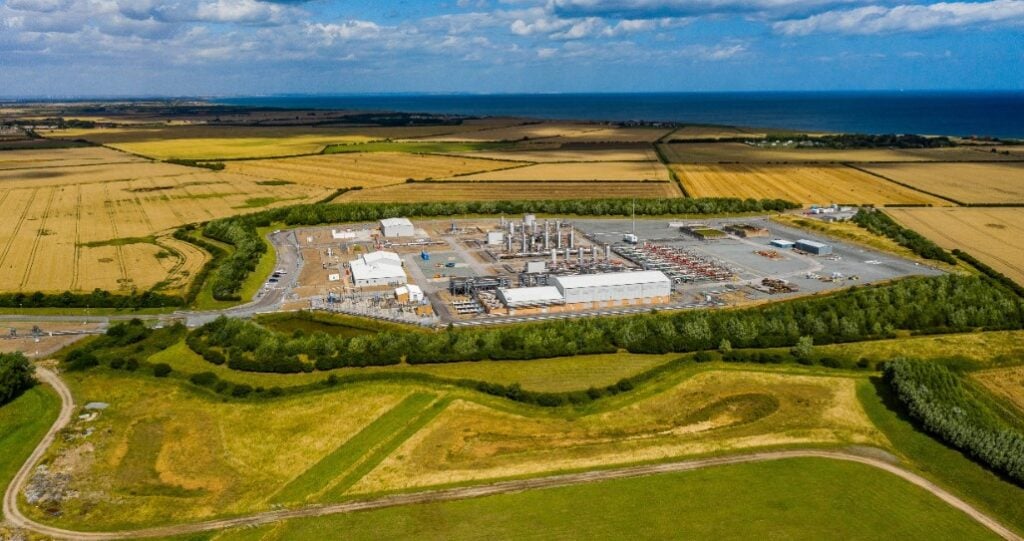SSE Thermal and Equinor have been granted planning consent for what they claim will be the UK’s first hydrogen-to-power project.
The Aldbrough Hydrogen Pathfinder, being pursued by SSE Thermal and partially (67%) Norwegian state-owned energy company Equinor, will combine several hydrogen use cases to create a low-carbon facility in the Humber.
The site will merge hydrogen production, storage, and power generation in one location, minimising the costs associated with hydrogen transportation and demonstrating an evidence base for deploying flexible hydrogen power in the UK’s energy transition.
Situated at SSE Thermal and Equinor’s Aldbrough Gas Storage site on the East Yorkshire coast, the hydrogen project aims to showcase the interactions between hydrogen electrolysis, hydrogen salt cavern storage, and 100% hydrogen dispatchable power.
Renewable energy from sources such as solar PV and wind will power the site via a power purchase agreement. This complies with the Low Carbon Hydrogen Standard, legislation introduced in 2022 that sets a maximum threshold for the greenhouse gas (GHG) emissions allowed during the hydrogen production lifecycle.
This renewable energy would then power a 35MW proton exchange membrane (PEM) electrolyser, which would be stored in a salt cavern and used in a 50MW 100% hydrogen-fired open-cycle gas turbine.
The hydrogen produced here will then either be exported as green power back to the national grid or, in the future, used to power hard-to-abate sectors such as transportation and industrial processes.
Sally O’Brien, senior project manager on the Aldbrough Hydrogen Pathfinder Project, hailed the combination of hydrogen production, storage, and power generation as a way to showcase the technology’s potential in the UK’s energy transition.
“By integrating hydrogen production, storage, and power generation in the Humber, we hope to create new opportunities for investment in the region, while advancing national clean power and decarbonisation goals,” O’Brien said.
“Over the last two years, we have engaged with the community, ahead of and throughout the planning process, as part of our commitment to being a trusted developer and a good neighbour. The project will bring growth to the region through our supply chain partnerships and engagement with local businesses.
The UK government shortlisted Aldbrough Hydrogen Pathfinder in Hydrogen Allocation Round Two (HAR2), which seeks to allocate revenue support through the Hydrogen Production Business Model.
An exhibition for various hydrogen technologies and use cases
Several hydrogen-based technologies and methods will be showcased as part of the project, helping to exhibit how these can contribute to the maturing hydrogen market in the UK. The first will be the use of a PEM electrolyser.
A PEM electrolyser differs from an anion exchange membrane (AEM) variant primarily through differences in energy conversion efficiency. Although experts widely consider AEM technology the best way to produce low-cost hydrogen, it is less efficient than PEM in creating high-purity hydrogen.
Despite this, AEM electrolysers do have advantages. The technology is often cheaper to manufacture and operate due to using less expensive materials and eliminating the need for costly catalysts like iridium. In addition, AEM electrolysers are designed with a modular approach, which makes them easier to scale up or down to meet different production needs.
It is worth noting that both technologies are still relatively nascent. However, PEM electrolysers are maturing faster than their counterpart and are the more popular of the two globally.
Salt cavern hydrogen storage will also be on show as part of the project. These natural caverns have been touted as an exemplary method for large-scale hydrogen gas storage. They could provide a more affordable option than other storage methods, such as cryogenic tanks or depleted gas fields.
This hydrogen storage method is currently in use. Linde, a global chemical company, has operated the world’s first commercial hydrogen high-purity cavern in Texas for nearly a decade. This underground storage cavern is designed to supply customers with hydrogen during planned and unplanned peak demand periods.






